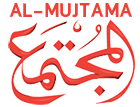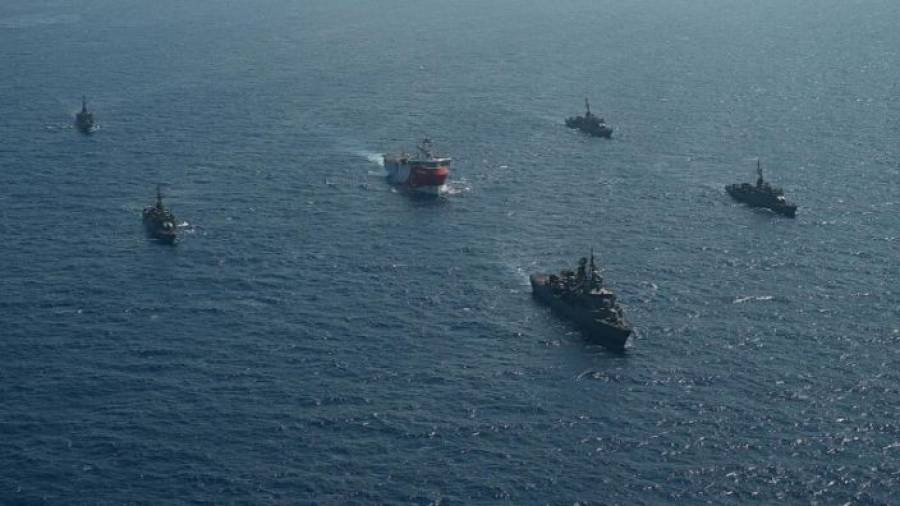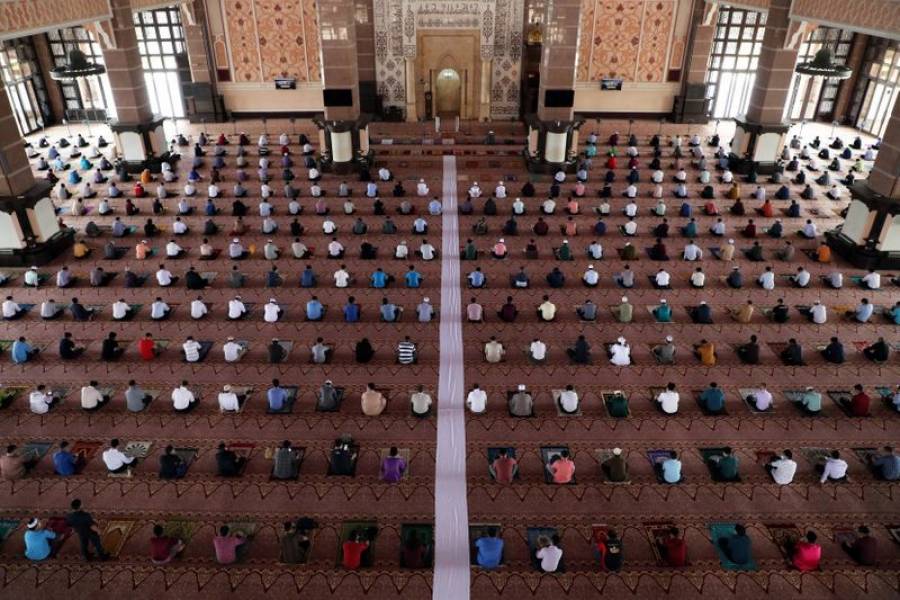Hamas Symbolism (4)
September 24, 2024Our interests are defined by our experiences and emerge from a central idea.
Some desire that we move from the narrowness of rigid opinions to the expansiveness of interest-based estimation. While this is correct, it requires careful examination. Expansion should be in line with the essence of jurisprudence. The scholars of “Hamas” and “Iraqi Jihad” are the boldest in balancing and relative perspectives. Their experiences are extensive in the field of interest-based fatwas. However, the approach of all jurists is to adhere to experimental evidence, which is a necessity after adhering to the divine text. Experimental evidence may be something that all humans can understand, but most of it is a faithful understanding exclusive to believers and inaccessible to Easterners and Westerners. Some of it is divine inspiration given by Allah to the sincere and pious. Therefore, the mujahid mufti avoids recklessness, naivety, trust in non-believers, seeking good from an oppressor even if he is a Muslim, cruelty of heart, and mixed intentions from an ally even if he is a fighter or opponent of globalization.
The Muslim leader is compassionate towards the tears of an orphan, the sighs of a widow, and the wailing of a mother. However, he understands that Allah's wisdom in making people struggle and fight to eliminate corruption on earth necessitates submission to the realities of harm and that hope entails pain. “Hamas” will not sell the heritage of the call in thought, chastity, purity, and clarity cheaply. They are generous like their noble jihad campaigns, but they do not squander their virtues. They struggle alongside other noble jihad ranks without claiming exclusive rights. However, they have openly stipulated conditions that must be fully understood by those dealing with their complete jihad conception, without fragmentation.
This conception is based on a central idea in their planning that must be understood by the combatant soldier as well as the leader:
“Hamas” methodology aims to delay reconciliation, peace, and normalization with “Israel” for as long as possible until the establishment of an Islamic state or a group of Islamic states that sincerely and courageously take on the Palestinian cause. “Hamas” foresight in this is correct, and the Iraqi jihad cause has proven it. “Israel” survives by America's sponsorship and protection. Iraqi jihad strikes are about to force America to withdraw. In America, there is intense debate that may develop into a general American withdrawal plan, possibly expanding to include abandoning “Israel.” Thus, “Israel's” end becomes conceivable. The European stance also seems to lean towards this, and China, the East, and Russia are preoccupied with escaping American globalization. Consequently, an Islamic state or a state of sincere individuals might seize the opportunity of the weakening of “Israel’s” global supporter to launch a faithful campaign to remove “Israel.” The political developments in the Arab countries and the Islamic world suggest that matters are moving towards better leadership. Governments and parties have failed, the Islamic awakening has spread, practiced politics, mastered jihad, and the American occupation of Iraq has awakened Islamic energies from their slumber, freed plans from their constraints, causing jihad sentiments to reach its peak. Reading the future allows for believing in dreams, and there are indications in the promises of our religion. From all this, “Hamas” ideology is formed. Islamic thought research fills the ears, and the scenes of the march fill the eyes, transmitted by satellite channels. With a few more years of patience, hearts will be filled with confidence, awareness, and joy.
Victory Emerges from Methodology and Patience
The pioneering mujahid constantly faces contradictions in the actions of political and jihadist factions, which are sometimes difficult to interpret and cannot be explained by jurisprudential measures and planning rules. This is a natural aspect of human life that working personalities are not exempt from. For such matters, Caliph Al-Ma'mun recommended patience for Abdullah bin Tahir, his chief of police to reach clarity and correct decision-making.
This has been established as a high political and planning wisdom in both structure and meaning. Muslim preachers and mujahideen are the ones who should renew it today, making deliberation, good listening, and contemplation during problems, conflicting statements, and positions a trademark. This wisdom calls them to listen with their minds and hearts, not just their ears. They should not be provoked by oddities, leading to quick reactions that complicate matters. Instead, they should have the judgments of a wise person who thinks enough before speaking. Quick reactions and sharp tongues are of those unrestrained by the norms and ethics of jihad and preaching, who do not understand the rules of justice and law, and whose souls are not peaceful through educational methods. This wisdom, as it refines us, the people of faith, also warns the hasty, envious, and enemy, and those who become narrow-minded when they see the success of any Islamic awakening figure. Numerous lively examples indicate that the beginnings of some seditions and problems delaying the Ummah's interests were rooted in unjust and fabricated actions by a hasty leader avoiding patience and monopolizing rights. Wronged souls tend to respond with obstinance and defiance, creating problems from which impurities and evils emerge. The careful leader of public interest curses the devil and first resorts to faith, forgiving and pardoning. Any further provocation and excessive aggression is likely to prompt responses, as souls have been endowed by their Creator with innate dignity, enhanced by faith, making it the pinnacle of honor. At this point, our primary experimental wisdom, advising that firm self-confidence is the remedy for the source of annoyance, proves true.
-------------------------------------------------------------
Hamas Symbolism (3)
September 19, 2024We remain ready, and not distracted by vanity.
Just as this success and integration has become a source of pride, it also imposes a shared burden on both causes: to fully absorb the lessons of the current stage in light of ancient wisdom. Since the elections in Iraq and Palestine are only forty days apart, the collective advice for both is: do not lay down your arms, no matter how abundant the political and electoral gains may seem. The proper time to lay down arms will be when the occupier withdraws, the effects of occupation are erased, the land returns to its people, and rights are restored.
The most important thing is that both jihads do not fall for the democratic deception, settling for a ministerial or even presidential position.
Sixty years ago, Mohammad Natsir and the Masyumi Party, along with its militant wing “Darul Islam,” fought until Indonesia's independence was achieved after World War II. The secular and opportunistic faction wanted to steal the revolution and monopolize it without including Darul Islam, Masyumi, or the broader Islamic movement, but they feared the armed strength they possessed.
President Sukarno's clever plan was to make the righteous man, Dr. Muhammad Natsir, the head of the Masyumi Party, the Prime Minister. This was to convince him that he held actual power. Once assured, Sukarno convinced Natsir that the stability of Indonesia hinged on the mujahideen laying down their arms and handing them over to the government to enable a strong centralized rule. Muhammad Natsir exerted great effort, using all logical arguments and persuasion to convince Darul Islam, believing there was no danger since he was the Prime Minister.
However, the leaders of Darul Islam refused and resisted, and Natsir increased his pressure until he brought them down from the mountains and out of the forests where they were fortified. He took their weapons away, and once he had completed this, Sukarno disposed him along with his power. Muhammad Natsir blamed himself until his death, and the leaders of Darul Islam continually reprimanded him. But it was too late for regret, as he had lost his strong military arm in a devastating blow from which it never recovered, making it easy for Sukarno to imprison them and exercise various forms of tyranny against them.
Even if the weapons were to be available again, the psychological shock caused by the wrong decision, deeply flawed and overly simplistic, along with the apparent naivety, would prevent any revival. The psychological impact after losing the symbol of honor and its instrument meant that the fervor, enthusiasm, and drive built up over years through educational methods could be dispelled by a single psychological setback stemming from an unwise decision.
This experience serves as a lesson for both the Iraqi and Palestinian jihads, teaching them to use elections, ministerial positions, and government roles as peaceful means to support combat pressure without considering them as ends in themselves. They must not abandon their grand strategic jihad goals, nor should they lay down their arms. Even agreements on independence, freedom, and the restoration of rights require the continued presence of arms for a period to ensure implementation, meet demands, and prevent deception. Any descent from our organizational heights, which we have fortified ourselves within, would mean revealing our secrets, numbing our aspirations, and sowing seeds of discord among the mujahideen due to differing political opinions.
In the Palestinian context, today there are two competing assets: the asset of jihad, faith, sincerity, and dedication, versus the asset of Oslo, submission, administrative corruption, and exploitation of the downtrodden. The shrewd should not deceive the valiant, and it must be remembered well how in the 1970s, in the Al-Qattan Mosque in the Al-Nakra neighborhood of Kuwait, the youth of the Palestinian community would gather for Al-Rashed to give them lessons about the Islamic path, the nurturing of elites, the feeling of superiority and separation, or about jihad jurisprudence and its equations, or about balanced steps and strategic planning. Those educational sessions were exemplars for the environments where some Hamas leaders were nurtured, and some of its fighters grew up.
Iraqi jihad leaders remember well the gesture to a high moon that does not set, a dawn that heralds, and a shining sun that does not wane. Before them, during the war, there was early talk about the lack of jihad security under intelligence services, and the call for immediate jihad after the missiles ceased, with a U.S. Marine face-to-face with an Iraqi fighting the infidels. Over time, they have learned the lesson to maintain their strength even after the American withdrawal to address potential civil war scenarios from factions that oppose historical wisdom and seek to eliminate the other side, intertwined with malicious sectarian desires, and falsehoods codified in an unjust constitution in a moment of negligence by the free. This situation has become entrenched in Jewish plans that aim to divide Iraq, hidden behind the allure of federalism terminology.
This firm conviction has produced numerous “work doctrines” and “performance equations,” forming a distinctive methodology in “contemporary jihad” with its jurisprudence and added efforts, inherited from the legacy of “Islamic jihad” over the centuries. We must avoid deviation, eccentricity, or softness today, but instead, adhere to the inherited wisdom from trusted sources, adding further good, and deriving what suits the new reality.
We adhere to the doctrine of taking refuge under the clouds of the sky, olive branches, and green palm fronds, not under pavilions stained with the blood of oppressed Muslims.
We take pride in discovering the doctrine of independence on the day of mingling.
We follow the Hanafi doctrine of Karaha Tanzihiyya (actions that are not forbidden but are better avoided), avoiding sources of contamination.
We embrace the principle of strict separation, adhering to the prohibition of impurity.
We take pride in the doctrine of superiority on the righteous and lofty path.
We lean towards the doctrine of legal precaution, from doubt to certainty.
We sing songs of chastity and chants of loyalty and disavowal.
In all this, there are covenants, pacts, and contracts, witnessed by Allah, with days as our testimony, and people as our witnesses. We have written stories, set examples, and chanted verses of optimism, hope, and aspiration.
And Allah is the most protective, He is the guardian of fate.
-------------------------------------------------------------
A message written by Sheikh Muhammad Ahmad Al-Rashid following “Hamas” winning the elections in Palestine.
Source: “Palestine Dialogue Network.”
Hamas Symbolism (2)
September 16, 2024The testimony is: Hamas has mastered and fulfilled its purpose.
The reason for its success and achieving perfection is that it does not rely on mass popular work but rather on selective educational work, picking the elite, educating them in private, and deepening their understanding before training them for battles. Thus, it provides elements characterized by strong will and foresight, making the popular alignment a reflection of the presence of these scholarly soldiers.
In times of need, the true nature of men is revealed.
During battles, the sword becomes sharper when wielded by a fervent heart.
A weapon damaged by rust will not be useful, no matter what.
Just as people adorn sword scabbards with gold and glittering jewels, competing and increasing in this, the blades inside differ in sharpness. Similarly, men are adorned with clothes, positions, and titles, but some hearts beneath the surface lack resolve and charisma, providing neither benefit nor action. They are like fruit with rotted pulp, leaving only the peel.
However, Hamas has made the sword the noblest of Allah's gifts to the people of Palestine, to the people of Iraq when the cowboys invaded, to Muslims in general, and to the free people worldwide, through the contagion of goodness and the subconscious imprint with every news of jihad and every image of a martyr preceding his brothers to Jannah.
In the language of Hamas, the sword has become:
- A tool of rescue, an instrument of pride, a supporter of firmness...
- A man's support, a protector of women, and a defender of neighbors...
- A messenger rising to demands...
- And a servant achieving goals. (1)
Hamas's practices have divided people worldwide into two teams. Among the men are symbols of pride, adorned with determination, preventing aggression against the nation, rising to every noble demand, making the missionary axis the methodological center for every act of jihad they intend to perfect.
Next to them are the weak, lazy, chaotic, backward who do not live in their era, ignorant who disdain knowledge, cowards who fear confrontation, and selfish who sit idly watching the battle.
The distinction has become so clear that every sincere person has to ask themselves: to which team do they belong? Perhaps a sincere person would even accuse themselves, seeing no bounds for sacrifice other than the highest limits practiced by Hamas, which became an example.
Through the centuries, the young men of jihad have had a passion different from the worldly desires of other youths, full of noble meanings and sublime emotions, with mutual advice among their group.
This has been Hamas's approach since it affirmed its Islamic identity, making all the experiential jihad heritage an educational curriculum for its fighters, starting from the era of the noble companions, passing through the middle ages, and continuing to the contemporary mujahideen.
Hamas first narrates to its youth the stories of how the young companions were skilled and meticulous horsemen, like the story of Abdullah bin Umar bin Al-Khattab - may Allah be pleased with them - where the Prophet (peace be upon him) raced the horses. Abdullah said: “I was a horseman that day, and I overtook the people until my horse crossed the mosque of Banu Zuraik, almost going as high as the mosque.”
(Abu Ubaid said: He means the horse leaped with him until it almost equaled the mosque in height, (2) as if there were high obstacles the racer had to overcome, similar to today's game.) The origin of the hadith is from Sahih Al-Bukhari.
Reading Abdullah bin Umar's accounts in worship and hadith narration might make one think he was an ascetic who only knew sitting and spreading knowledge, but he was the foremost knight.
Not to mention the recount stories like that of Abu Sa'id Khalaf bin Muhammad Al-Yahsubi Al-Surti Al-Maliki, who died in 319 AH, and his son Sa'id said:
“My father had studied the Quran with Abu Abdullah Muhammad bin Khairun, the reciter, for a long time. Whenever Ibn Khairun went to Sousse for jihad, Abu Sa'id would follow him... He had a beautiful voice in reciting the Quran... His son said: I used to accompany him to jihad, and every night in Ramadan, he would lead us in prayer, with a congregation gathering behind him, and I would hear weeping and sobbing from everywhere. He was skilled in horsemanship, fond of buying horses, and would take them to the jihad to guard the Muslims. He would sometimes leave Sousse with Abu Ja'far Ahmed bin Sa'dun Al-Arbisi and Abu Bakr bin Abi Uqba, standing in a row as if the enemy were before them, running their horses until the sun rose.” (3)
As for the contemporary experience, it is not narrated but lived, shaping “the Palestinian society concerned with the Palestinian cause” into an ideal environment for teaching and imparting the art of jihad and revolution to the entire Islamic world, along with leadership skills and dealing with the complexities of international relations and the ferocity of globalization.
The origin of this Hamas's capability stems from the collective Palestinian experience. The leadership phenomenon in driving life does not come from an individual leader or a single organization or party but also from a society with unique characteristics granted by its way of life within the larger community. The clearest example is the “Quraysh society” and its leadership role concerning the larger Arab society, facilitated by Quraysh's commercial life and the Arab pilgrimage to Mecca.
Abu Bakr Al-Siddiq, may Allah be pleased with him, explains this in his speech to the Ansar on the day of the Saqifah, justifying his claim to the caliphate: “The Arabs were torn away from us just as the millstone is torn from its axis. We were the center, and the Arabs revolved around us like the millstone.” (4)
The Arabs were torn away from us, meaning they were separated from us, making Quraysh the axis around which the Arabs revolved. This leadership position developed gradually and over a long time without artificiality or affectation.
Urban inhabitants are generally more aware than the Bedouins and more experienced in politics, and the people of capitals are more influenced by it than those in the outskirts. Any city or region with a lot of literature, knowledge exchange, and intellectual research becomes, after a while, capable of influencing leadership in its surroundings.
Because this phenomenon exists, the preaching orientation naturally tended to dominate some dynamic movements and to discover and develop the opportunities around it.
The Palestinian jihad bloc supporting the Palestinian cause has reached a level of complete momentum, capable of spreading its methods, plans, convictions, and experiences to every other oppressed and unjust cause. This was most evident in its direct and decisive impact on the “Iraqi cause” and the rapid Iraqi response to the call for jihad, merging and uniting the two causes, which was the ultimate success of Hamas.
-------------------------------------------------------------
(1) Al-Basair 5/132
(2) Lisan Al-Arab 2/598
(6) Aayan Ulama Libya/64 by Nasir Al-Sharif, referring to the book “Riyad Al-Nufus.”
(7) Lisan Al-Arab 1/526
A message written by Sheikh Muhammad Ahmad Al-Rashid following “Hamas” winning the elections in Palestine.
Source: “Palestine Dialogue Network.”
Hamas Symbolism (1)
September 12, 2024The “Palestinian cause” stands as a clear example in this era of injustice and oppression. Allah decreed that the Palestinian people would be oppressed and persecuted by the Jews and the major powers for an entire century, preceded by a century of preparation since the time of Napoleon. Not to mention the Muslims' negligence in the matter of Palestine.
There was no complete negligence from the people of Palestine or the general Muslim Ummah. They tried and defended repeatedly, but if an effort is not controlled by a skillful plan, a sincere, aware leadership, supported by equivalent media, and sufficient funding, it is more akin to a flare-up and naive reaction. This was the fate of Palestine until the emergence of the “Hamas” movement, which imposed itself on the scene, representing a block of jihad with pure hands, advancing with insight, study, and a conscious strategic vision, with clear ideological and intellectual principles. Thus, every Muslim is allowed to finally anticipate an awaited victory.
In the early Islamic life, there were practices of freedom that remain the root for those who want to establish and revive their ways, with Sharia scholars at the forefront. For example, Shuraih Al-Qadhi was known for not allowing oppression.
Sharia scholars deal with daily injustices and oppression in people's lives when conducting transactions and contracts, but Shuraih's indication to something greater is a lesson for every Muslim to strive for freedom and dignity. Political freedom is built on the foundation of civil rights and judicial justice. The impartial judge creates an environment that nurtures the mujahid and the uprising politician.
“Hamas” Distinct Method in Jihad
These feelings gain another psychological dimension when they are Palestinian, due to the harsh migration imposed on them. The emigrant and oppressed person yearns intensely for his homeland, feeling like a camel restrained from movement.
the Palestinian who is restrained: half of his time is occupied with livelihood concerns, and the other half with suppression, to keep him away from any kind of of revolution and jihad, and to prevent him from deviating from domestication plans.
Even if the enemy's plans have succeeded in exhausting us at times, this does not justify despair finding its way to us, because a discerning look at the twists and turns of time and the nature of life teaches us that no state lasts forever, and hardship is inevitably followed by ease. Within that, opportunities for improvement and compensation arise. One of the most important observations in the movement of life is that it is not a continuous stream but rather intermittent. This observation is widely acknowledged among people that days rotate.
Change is a constant attribute, and it is what generates movement; it does not stagnate in one state but is always in flux. Here, everyone has the right to experiment, so the methods of work are relied upon to achieve hope or remain in confusion.
This is what gives “Hamas's” method of jihad its great value. The issue is not related to leadership or elections but to a comprehensive methodology, a system of values and integrated plans. The merit of “Hamas” is a branch of the clarity of its method, and the creativity of its leadership is a product of the ideology it believes in.
A Master's Blow
Just as moderation was the hallmark of the soundness of Islamic thought, avoiding extremes, political jihadist moderation is the strong pillar on which “Hamas” has relied, making its positions upright. Rationality has become its characteristic, relativity a means of interpreting what may seem contradictory, and reconciling two rights a safe way out of unilateral vision. It is as if “Hamas” has adhered, since its emergence and throughout its progress, to the counsel of the wise Arab Aktham bin Saifi al-Tamimi who said, “Negligence and lack of deliberation, leads to losing determination.” (1)
He points to two extreme opposites in which the chance for opportunity is lost: laziness and delay, or haste without allowing for deliberation and planning. The prudent is supposed to be moderate, with a pause for contemplation between his movement and attack. Neglecting deliberation is more dangerous than negligence, for the one neglecting his duties can be admonished and catch up, achieving half the result if he misses the full one, or perhaps grasp the tail of the opportunity if not the forefront. But the reckless one is deterred, burdened, unable to move for a long time, requiring a period of solace and treatment. The mujahid leader preacher knows both and how to seize the right moment.
“Hamas's” participation in the political arena and its presence in the Palestinian Legislative Council elections is a decisive step at the right time, embodying the slogan “Creativity in Seizing the Moment,” backed by courage, bolstered by its victories in municipal elections.
Our ancestors used to say: “He who dares, succeeds; he who fears, fails.” (2)
This is not a call for recklessness, but the essence of vital experimentation is clear. History proves that the world, in part of our approach to it, is taken by force. This force requires initiative, self-confidence, boldness, and quick decision-making, as the field is full of competitors with resources and funds. Any excessive demand for guaranteed results may contain a small seed of fear that can grow under the cover of excessive caution to become a psychological barrier, preventing the investment of opportunities, leaving them to the greedy and treacherous. All that remains is blame and self-reproach. Thus, “Hamas” avoided many negatives with its initiative, characterized by meticulous planning.
The believer believes that fate is above these arts of delay and haste and planning principles.
However, the believer should not surrender to negative fate, let alone to the fear of its occurrence. Rather, part of his faith is to combat bad fate with good fate. “Hamas,” in all its steps, balances, maneuvers, pulls, and releases, then pulls again. These are the laws of political and jihad practice. The image of “Hamas” leaders is like sailors with their boat swaying, pushed by the wind on the sail. They pull the ropes of the sail for balance, preventing it from capsizing. This scene is seen today on television during yacht races.
This depiction of a partial, vital, maritime movement is a creation of an intelligent Bedouin, even miraculous. Just as he described the camel and the desert extensively, he described the sea and the ship's movement, marveling at the wisdom of the comprehensive movement. What matters to us here is the ship's balance. What matters to us about “Hamas” is the balance of performance and positions in difficult days with complex equations. The art of pulling ropes has become a precise art. Those who want to sail safely in the globalization ocean, not far from the heat of Iraq's events, must master it.
-------------------------------------------------------------
(1), (2) Al-Basa’ir wa al-Dhakha’ir by Abu Hayyan al-Tawhidi (1 / 154 / 227).
A message written by Sheikh Muhammad Ahmad Al-Rashid following “Hamas” winning the elections in Palestine.
Source: “Palestine Dialogue Network.”










